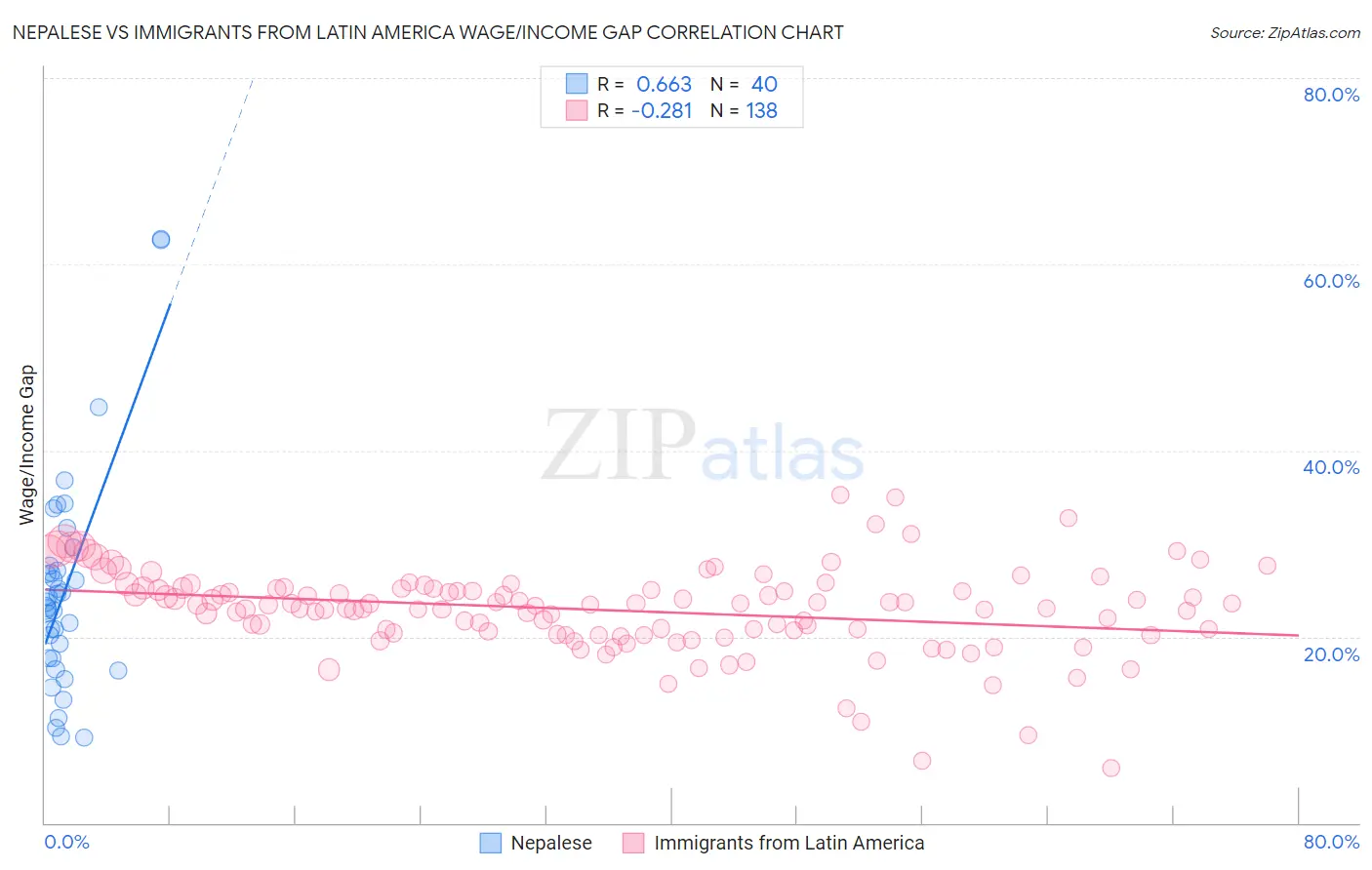Nepalese vs Immigrants from Latin America Wage/Income Gap
COMPARE
Nepalese
Immigrants from Latin America
Wage/Income Gap
Wage/Income Gap Comparison
Nepalese
Immigrants from Latin America
22.2%
WAGE/INCOME GAP
100.0/ 100
METRIC RATING
54th/ 347
METRIC RANK
23.7%
WAGE/INCOME GAP
99.2/ 100
METRIC RATING
98th/ 347
METRIC RANK
Nepalese vs Immigrants from Latin America Wage/Income Gap Correlation Chart
The statistical analysis conducted on geographies consisting of 24,519,153 people shows a significant positive correlation between the proportion of Nepalese and wage/income gap percentage in the United States with a correlation coefficient (R) of 0.663 and weighted average of 22.2%. Similarly, the statistical analysis conducted on geographies consisting of 556,436,058 people shows a weak negative correlation between the proportion of Immigrants from Latin America and wage/income gap percentage in the United States with a correlation coefficient (R) of -0.281 and weighted average of 23.7%, a difference of 6.8%.

Wage/Income Gap Correlation Summary
| Measurement | Nepalese | Immigrants from Latin America |
| Minimum | 9.1% | 5.9% |
| Maximum | 62.8% | 35.2% |
| Range | 53.7% | 29.3% |
| Mean | 25.0% | 22.9% |
| Median | 23.4% | 23.4% |
| Interquartile 25% (IQ1) | 17.7% | 20.4% |
| Interquartile 75% (IQ3) | 27.4% | 25.2% |
| Interquartile Range (IQR) | 9.7% | 4.8% |
| Standard Deviation (Sample) | 11.7% | 4.7% |
| Standard Deviation (Population) | 11.5% | 4.6% |
Similar Demographics by Wage/Income Gap
Demographics Similar to Nepalese by Wage/Income Gap
In terms of wage/income gap, the demographic groups most similar to Nepalese are Bangladeshi (22.2%, a difference of 0.23%), Immigrants from Cameroon (22.2%, a difference of 0.24%), Tohono O'odham (22.1%, a difference of 0.32%), Immigrants from Zaire (22.3%, a difference of 0.40%), and Immigrants from Ghana (22.3%, a difference of 0.43%).
| Demographics | Rating | Rank | Wage/Income Gap |
| Immigrants | Congo | 100.0 /100 | #47 | Exceptional 21.7% |
| Blacks/African Americans | 100.0 /100 | #48 | Exceptional 21.7% |
| Ethiopians | 100.0 /100 | #49 | Exceptional 21.8% |
| Immigrants | Western Africa | 100.0 /100 | #50 | Exceptional 22.0% |
| Tohono O'odham | 100.0 /100 | #51 | Exceptional 22.1% |
| Immigrants | Cameroon | 100.0 /100 | #52 | Exceptional 22.2% |
| Bangladeshis | 100.0 /100 | #53 | Exceptional 22.2% |
| Nepalese | 100.0 /100 | #54 | Exceptional 22.2% |
| Immigrants | Zaire | 100.0 /100 | #55 | Exceptional 22.3% |
| Immigrants | Ghana | 100.0 /100 | #56 | Exceptional 22.3% |
| Ghanaians | 100.0 /100 | #57 | Exceptional 22.3% |
| Immigrants | Cuba | 100.0 /100 | #58 | Exceptional 22.4% |
| Navajo | 100.0 /100 | #59 | Exceptional 22.4% |
| Immigrants | Middle Africa | 100.0 /100 | #60 | Exceptional 22.4% |
| Immigrants | Fiji | 100.0 /100 | #61 | Exceptional 22.4% |
Demographics Similar to Immigrants from Latin America by Wage/Income Gap
In terms of wage/income gap, the demographic groups most similar to Immigrants from Latin America are Aleut (23.7%, a difference of 0.070%), Yakama (23.7%, a difference of 0.090%), Japanese (23.8%, a difference of 0.25%), Immigrants from Laos (23.8%, a difference of 0.39%), and Immigrants from Sudan (23.6%, a difference of 0.40%).
| Demographics | Rating | Rank | Wage/Income Gap |
| Arapaho | 99.6 /100 | #91 | Exceptional 23.5% |
| Immigrants | Honduras | 99.5 /100 | #92 | Exceptional 23.5% |
| Immigrants | Cabo Verde | 99.5 /100 | #93 | Exceptional 23.6% |
| Hondurans | 99.5 /100 | #94 | Exceptional 23.6% |
| Cape Verdeans | 99.4 /100 | #95 | Exceptional 23.6% |
| Kiowa | 99.4 /100 | #96 | Exceptional 23.6% |
| Immigrants | Sudan | 99.4 /100 | #97 | Exceptional 23.6% |
| Immigrants | Latin America | 99.2 /100 | #98 | Exceptional 23.7% |
| Aleuts | 99.2 /100 | #99 | Exceptional 23.7% |
| Yakama | 99.2 /100 | #100 | Exceptional 23.7% |
| Japanese | 99.1 /100 | #101 | Exceptional 23.8% |
| Immigrants | Laos | 99.0 /100 | #102 | Exceptional 23.8% |
| Tsimshian | 98.9 /100 | #103 | Exceptional 23.9% |
| Tlingit-Haida | 98.7 /100 | #104 | Exceptional 24.0% |
| Moroccans | 98.6 /100 | #105 | Exceptional 24.0% |